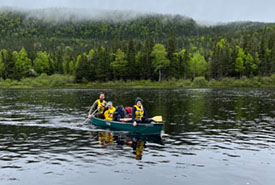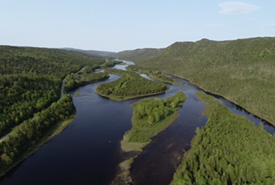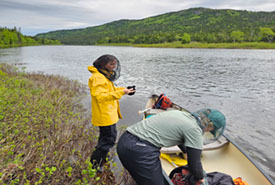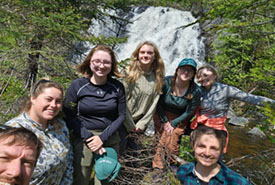Lloyds River: An unexpected journey

River Crossing, NL (Photo by Kayla Fisher/ NCC staff)
One Sunday evening, a team from the Nature Conservancy of Canada’s (NCC’s) Newfoundland and Labrador office waited anxiously for news of a helicopter. The team of three interns and three full-time staff were about to begin the most exciting part of a two-week journey.
The plan was for them to spend a few days in NCC’s remote Grasses Nature Reserve. They would have to fly in by helicopter, as the reserve is not easily accessible any other way, but the weather turned out not to be in their favour. The helicopter became stuck behind a bank of fog and rain sitting over the Avalon Peninsula on the southeast shore of the island, and it couldn’t reach the team in the west.
The team had already spent a week in the field, monitoring various NCC properties on the west coast of the island. The Grasses Nature Reserve was the second-last location on their list, and they were running out of time if they wanted to finish the expedition within two weeks. So, on Monday, they all sat down and started to brainstorm a new plan.
“I think it was Piers who had this crazy idea,” says intern Julia Ball, speaking about Newfoundland program director, Piers Evans. They didn’t want to waste the preparation they had made and resources they had gathered for the off-grid trip, so they decided to leave the Grasses Nature Reserve for another year and head to a different one. The Lloyds River Nature Reserve is the second most remote NCC property in Newfoundland. “And with Lloyds River,” notes Julia, “you don’t need a helicopter.”

Lloyd's River Nature Reserve, NL (Photo by Piers-Evans/NCC staff)
Tuesday morning, the team canoed down a river toward the Lloyds River Nature Reserve. They set up camp around an open canopy, near an area of the woods that was once the location of a logging road, but had since been reclaimed by the forest. The group had expanded to include two staff from Birds Canada and a master’s student from Memorial University of Newfoundland.
The three interns set up their tents close together. As Julia lives on the west coast of the island, this two-week expedition was the first time she had met east coast interns Olivia Lymburner and Kayla Fisher in person. Despite just meeting, the three of them got along spectacularly, chatting every night before settling down for bed.
Each morning, the team of nine split into four groups to accomplish the various tasks that they had set out to do. Julia spent two days conducting a bioblitz with the master’s student. They documented over 200 species living on the nature reserve. Of this list, some of the group's favourites included sundew, blue flag iris, bakeapple berry, pine marten, northern water thrush and ruby-crowned kinglet.

Preparing the canoe, NL (Photo by Piers Evans/ NCC staff)
Olivia and Kayla’s task was to explore and monitor the property. They travelled up and down the nature reserve, searching for species and ecosystems, and observing changes to the environment since NCC’s last visit. Olivia, along with NCC staff Jennifer Sullivan and Heather Baehre, took a day to climb all the way up to the plateau of the nature reserve, 300 metres in elevation.
The team climbed over hills and down into valleys, through beautiful fens and bogs and across boulder fields covered in squishy moss. Occasionally, they would catch glimpses of the rushing river through the trees. The sun beat down, hot on their backs as they trekked through the woods, but they agreed that it was well worth the effort.
“When we acquire these properties, we are agreeing to be stewards of these properties for the rest of time,” says Kayla.
“And in order to do that,” Olivia adds, “we have to have a good idea of what’s on the property, what kind of species are growing and living there, and just to understand the biodiversity of it.”

Group photo, NL (Photo by Piers Evans/NCC staff)
After a long day of work, each group headed back to camp. They all ate dinner together in the central tent, then made hot chocolate and told stories from their day's adventures while the frogs and toads croaked in the river nearby. This time spent together made the trip into the field more special than the interns could have imagined.
On Friday morning, they packed up the camp and canoed back up the river. The interns reflected on their time spent in such a solitary landscape. “We are a handful of the very few people who have seen or will ever see Lloyds River,” Kayla muses.
As the team floated away, the Lloyds River Nature Reserve was left alone once more. It will remain intact and undisturbed for years to come.




